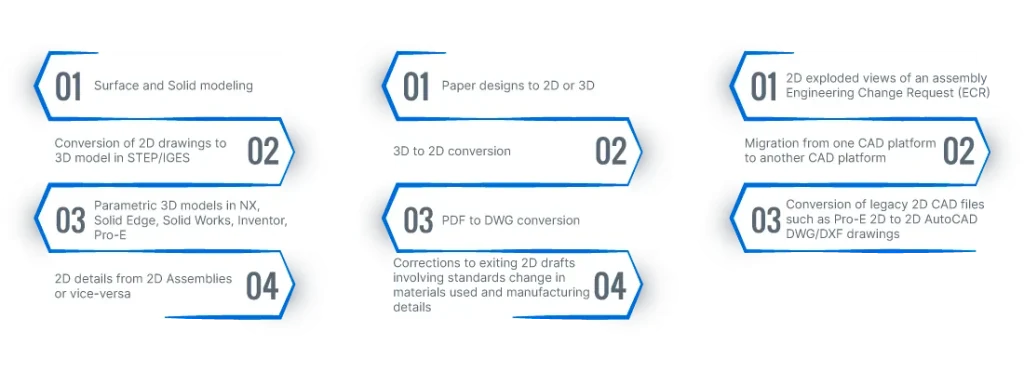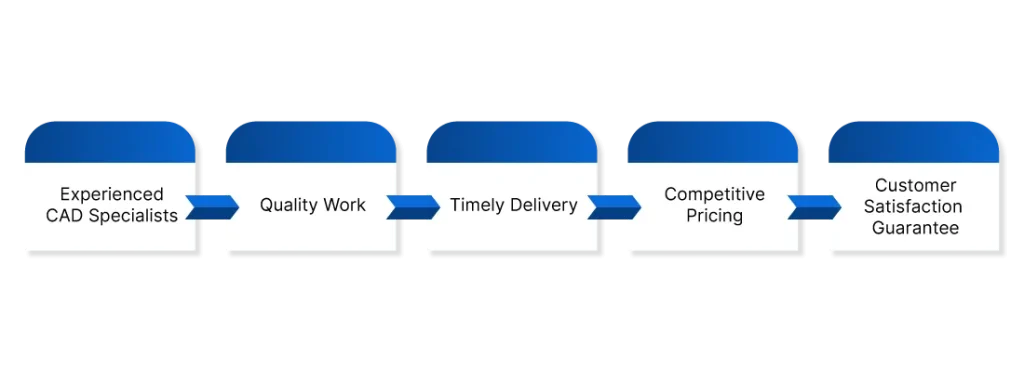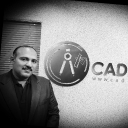Reverse Engineering CAD Engineering Services
Are you looking for high-quality and accurate 3D CAD design services for your next project? Look no further! Our team of experienced CAD specialists is here to help you bring your designs to life. We offer a wide range of CAD design services, including 3D modeling, 2D drafting, conversion, and migration services. Our CAD design process is transparent, efficient, and collaborative. We work closely with our clients to understand their requirements, and we provide regular updates throughout the design process to ensure that the final designs meet their expectations. Our process includes an initial consultation, project scope and proposal, design phase, quality control and review, and delivery and support. With our CAD design services, we can assure you of working with experienced CAD specialists who deliver quality work on time and at a competitive price.
Our CAD specialists have extensive experience in building 3D models, ranging from simple designs to complex assemblies, using a variety of software tools such as NX, Solid Edge, SolidWorks, Creo, Autodesk Inventor, CATIA, and more. We work closely with our clients to understand their requirements and provide accurate 3D models that meet their needs.
We understand the importance of accurate 2D drafting in the CAD design process, and we offer drafting services that cover all your needs. Our drafting services include converting your paper drawings and blueprints to digital formats, creating 2D drawings from 3D models, and drafting services for files from other CAD software platforms. We use industry-standard software tools such as AutoCAD and SolidWorks to create accurate and unambiguous 2D drawings that convey all the required information to the manufacturer.
We understand that many companies have legacy data in various file formats, and we offer conversion and migration services to help you move your data to a more modern platform. Our conversion and migration services can cover all your paper drawings, blueprints, and even files from other CAD software platforms. We can convert files to and from various formats, ensuring that you can work with your data in the software tools of your choice. We also offer additional services such as rendering and simulation, product design and development, reverse engineering, and more. Our team of CAD specialists has extensive experience in a wide range of industries, including aerospace, automotive, consumer products, and medical devices, among others. We pride ourselves on providing quality work, timely delivery, and competitive pricing to ensure customer satisfaction.
Conversion of 2D drawings to 3D model in STEP/IGES




Professionalism and work ethics… "The level of professionalism and work ethic you bring to the table is simply great. The fact that clicked the most is when you took complete responsibility for our product development and the outcome is exactly what we desired. Thank you Prescient."

First on our list, without doubt … “I greatly appreciate the software development work you have been doing for Level 3 Inspection for all these years. Your team’s skills and your methodical approach to perfection, coupled with your high level of professionalism, have made the road pretty smooth for us to achieve our organizational and operational integration goals. If we have to recommend a competent partner we can totally depend on, your name would be the first on our list, without a doubt. Thank you Prescient!”

They are the exception... "We've been working with Prescient Technologies for quite a few years now, and they continue to provide quality work in a timely manner for a reasonable cost. They are the exception to the two out of three rule! (Fast, High Quality or Good Price, pick two)"

There could not have been a better alternative… "It was a chance meeting with the Prescient team that set the ball rolling. Initially I was skeptical but their attitude “Together we can” inspired confidence. ”Hand-holding” by Prescient was exemplary and that was crucial for a start-up like ours. Our project in Orthopaedic navigation involved totally new objectives in as yet unexplored areas to be achieved with innovative steps in CAD domain. Few years down the line together we have added a chapter at the very edge of scientific knowledge. Thanks to Prescient our software idea has now evolved into a full-fledged market-ready product. Today I am convinced that there could not have been a better alternative."

Professionalism and work ethics… "The level of professionalism and work ethic you bring to the table is simply great. The fact that clicked the most is when you took complete responsibility for our product development and the outcome is exactly what we desired. Thank you Prescient."
Our CAD design services are suitable for a wide range of industries, including manufacturing, automotive, aerospace, defense, architecture, and many others. We have experience in creating 3D models and 2D drawings for various products, components, and systems.
Our team of CAD specialists has expertise in using a variety of software tools, including NX, Solid Edge, SolidWorks, Creo, Autodesk Inventor, CATIA, and more. We can work with the software tools of your choice.
Yes, we offer conversion and migration services that can cover all your paper drawings, blueprints, and even files from other CAD software platforms. We can convert your paper drawings or blueprints into 3D models and 2D drawings that are accurate and high quality.
The timeline for a CAD design project depends on the complexity of the project, the scope of work, and the number of revisions required. We will provide you with a timeline estimate during the initial consultation phase.
Yes, we encourage our clients to provide feedback and request changes or revisions to the designs throughout the design process. We will work closely with you to ensure that the final designs meet your requirements and expectations.
We have a rigorous quality control and review process that includes multiple checks and tests to ensure the accuracy and quality of the CAD designs. Our team of CAD specialists also has extensive experience in creating 3D models and 2D drawings that are precise and reliable.
Yes, we offer CAD design services for both prototypes and small production runs. Our team can work with you to design and create 3D models and 2D drawings that are optimized for manufacturing and production.
Yes, we are committed to protecting the confidentiality and intellectual property of our clients. We are happy to sign an NDA or any other legal agreements that are required to ensure the protection of your information and designs.
We can deliver the final CAD designs in a variety of file formats, including IGES, STEP, STL, PDF, and others. We will work with you to determine the best file format for your specific needs and requirements.
Have you ever had to halt production because a critical supplier failed to deliver on time? Many manufacturers struggle with broken links in the supply chain, especially when their digital tools can’t adapt fast enough. In today’s uncertain environment, it’s no longer enough to have a Product Lifecycle Management (PLM) system that just tracks internal workflows. You need one that connects, adapts, and responds across your entire supply network. This is where PLM customization helps. It extends the core capabilities of your PLM system to create resilient, adaptable supply chains and collaborative ecosystems across suppliers, design teams, and manufacturing partners. Why Standard PLM Isn’t Enough for Modern Supply Chains Traditional PLM systems are mostly built to serve internal engineering teams. They focus on managing product data, revisions, and approvals. But supply chains today involve global partners, suppliers, and external contributors. Static systems can’t handle this complexity. PLM needs to evolve from being a data repository to becoming a connected collaboration backbone. That transformation begins with customisation. How PLM Customization Supports Supply Chain Resilience 1. Design for Disruption Disruptions be it a pandemic, conflict, or material shortage can break traditional supply chains. Companies with custom PLM workflows can build alternative sourcing models and simulate supply risks before they cause damage. A customised PLM system can: According to Wired (2023), 75% of manufacturers plan to invest in digital resilience tools after recent global supply chain shocks. 2. Real-Time Supplier Collaboration Your suppliers shouldn’t be left out of your product lifecycle. A customised PLM platform can offer secure access to selected data, letting vendors contribute at earlier stages of design and manufacturing. Key features include: With PLM supplier collaboration, you reduce cycle time and improve component quality before a part reaches production. 3. Faster Workflows with Automation Manual approvals and data updates often cause delays. PLM workflow automation streamlines repetitive tasks by automatically routing files, notifying users, and logging changes. Common use cases include: This level of automation brings greater control and reduces human error. TechVersions reports that PLM automation can cut product development time by up to 35% (2024). Connecting the Digital Thread Beyond the Organisation The digital thread is the flow of data that connects every stage of your product lifecycle. PLM is a core part of this, but without customization, the thread often breaks when external partners come into play. PLM customization helps by: By building an extended thread, you ensure that everyone internal or external is working from the same up-to-date product data. Why Adaptability Needs to Be Built Into PLM Resilience is not just about reacting to crises it’s about adapting quickly. An adaptable PLM system allows you to: This flexibility makes it easier to meet customer demands, enter new markets, and respond to emerging challenges without rebuilding your system from scratch. Signs You Should Extend Your PLM Capabilities You might need PLM customization if: These issues become business risks as supply chains get more complex. A generic PLM setup cannot handle such variability. A customised one can. What Prescient Technologies Offers Prescient Technologies helps manufacturers build smarter PLM environments that go beyond engineering silos. We specialise in: Our team has delivered custom PLM solutions for leading global manufacturers across industries, making their product and supply data more connected, secure, and adaptable. Key Takeaways Ready to Extend Your PLM Capabilities? If your organisation is looking to improve product visibility, strengthen supplier networks, and build more adaptable operations, it’s time to extend your PLM system. 👉 Talk to Prescient Technologies about how PLM customization can make your supply chain more resilient, collaborative, and future-ready.Contact us to get started.
Read MoreCan Your CAD Tools Keep Up with Climate Demands? Manufacturers around the world are under pressure to reduce carbon emissions, minimise waste, and develop energy-efficient products. But there’s one question every engineering team should ask is your CAD software helping or holding you back from meeting your sustainability goals? As product lifecycles grow more complex and regulations tighten, traditional design workflows no longer suffice. Today, CAD software development plays a critical role in embedding sustainability from the earliest stages of design. It’s not just about creating shapes it’s about making smarter, lighter, and more responsible products. Let’s explore how CAD tools are being transformed to support material optimisation, reduce energy consumption, and minimise waste across the product development cycle. Traditional CAD Workflows Don’t Prioritise Environmental Impact For years, CAD software development focused on improving design accuracy and accelerating time-to-market. But sustainability was rarely a core concern. That’s changing. Here are key challenges with older CAD systems: According to a 2024 study by Lucent Innovation, nearly 45% of manufacturers now say their design tools must directly support energy efficiency and material reduction. Yet many still rely on outdated CAD kernels that are not optimised for environmental metrics. The Hidden Cost of Design Choices When sustainability is left out of early design, manufacturers face: A poorly optimised CAD model may look perfect on screen but lead to real-world waste. Every gram of material saved in a digital model could translate to tons of raw resource savings in mass production. Every kilowatt avoided during machining reduces your carbon footprint. So why not let CAD software development do the heavy lifting? Sustainable CAD Software Development Modern CAD platforms are evolving. They now come with tools that support sustainable engineering practices from the geometry core to energy-aware design features. 🔹 1. Material-Saving Design in CAD Prescient Technologies integrates geometric modeling and CAD kernels that prioritise structural strength with minimal material usage. This is not just efficient it’s sustainable. 🔹 2. Energy-Efficient CAD Modeling According to Wired, design-led manufacturing improvements can reduce energy use by up to 25% per product. 🔹 3. Waste Reduction with Smart Assemblies Through CAD automation, teams can build models that are easy to update and maintain, reducing digital and physical waste. Key Enablers Driving Sustainability in CAD Cloud-Based CAD Platforms They enable real-time collaboration and reduce hardware energy loads. AI in CAD Software Development AI recommends eco-friendly materials and flags unsustainable geometry. Integration with PLM and Simulation Tools Bridges the gap between product design and lifecycle management. Digital Twins Mirror physical assets for testing performance without building wasteful prototypes. Prescient’s experience in CAD software development and integration makes all of this possible in a single ecosystem tailored for manufacturing companies. What Makes Prescient Technologies Different? Prescient has delivered CAD tools and custom geometric modeling solutions for over two decades. The company blends deep domain expertise with CAD automation and AI-assisted optimisation to help clients reduce their design footprint. Key offerings include: These tools are built not just for performance but for the planet. Conclusion: Key Takeaways Looking to Build Sustainable Products from the Start? Contact Prescient Technologies to learn how our CAD Software Development services and automation tools can help your team reduce material use, energy costs, and waste right from the design stage. Let’s build smarter, greener products together. Explore our CAD offerings today – including geometric modeling, CAD kernels, and design automation.
Read MoreIn the rapidly evolving manufacturing and engineering environment, executing a proper Teamcenter implementation can mean the difference between fragmented data silos and seamless, collaborative workflows. As product complexity rises, companies must unify CAD, BOM, change management, and systems like ERP. A well-executed Teamcenter implementation becomes the backbone of innovation, enabling higher quality, faster time to market, and better control over the product lifecycle. This guide walks through the practical blueprint from greenfield planning to a stable go-live, with best practices and real-world insight for engineering leads, IT heads, and PLM champions. Setting the Stage: Planning Your Teamcenter Implementation Define Clear Objectives & Use Cases Begin by documenting the business challenges you intend to solve with Teamcenter. Do you want to: Clear objectives enable you to prioritize modules and keep implementation scope manageable. Secure Leadership Sponsorship & Governance Any PLM project risks stalling without visible executive support. Ensure your steering committee includes department heads from engineering, manufacturing, IT, and quality. Establish decision authorities, escalation paths, and success metrics. Conduct Current State Assessment & Gap Analysis Map existing tools, manual processes, spreadsheets, and data models. Capture how file sharing, CAD vaulting, BOM reconciliation, and change approvals currently operate. This “as-is” map allows you to spot gaps and target what to address in your Teamcenter implementation. Define Go-Live Scope (MVP Approach) Resist the temptation to deploy every feature at once. Define your MVP (minimum viable product) — e.g. CAD integration + revision control + change management for one product line. Defer optional modules (supplier portal, advanced analytics) for future releases. Architecture, Environment & Integration Planning Decide whether you will host on-premises, cloud, or hybrid. Plan server sizing, database architecture, network bandwidth, and disaster recovery.Also design integration touchpoints: CAD systems (e.g. NX, Creo, SolidWorks), ERP, MES, and other enterprise systems. Map data flow, API or middleware layers, and designate where transformations or validations occur. Design & Configuration Phase: Building Your Core System Data Model & Naming Conventions Create a robust data model: item, revision, dataset, classification, attributes, and relationships. Define standardized attribute templates and naming rules. This becomes the foundation of consistency across your Teamcenter implementation. Workflow & Process Definition Design your change process: CR (Change Request) → CA (Change Action) → ECO (Engineering Change Order). Include approval loops, notifications, escalation rules, and integration with change history. Before automating, validate process logic with domain experts. Role-Based Access & UI Configuration Configure roles, privileges, and UI views. Each user group (design, manufacturing, QA, procurement) should see a tailored interface. This ensures usability and reduces load on average users. Integration & Customization Develop connectors, web services, or scripts for data exchange with ERP, CAD, or PLM-adjacent tools. Use configuration first; minimize heavy customizations. Too much customization increases maintenance burden and upgrade risk. Expertia+1 Data Migration & Cleansing Legacy data migration is often underestimated. Clean duplicates, correct attribute inconsistencies, remove obsolete records. Transform data to match your new model, then load it in test environments. Validate integrity. cmscomputer.in+1 Prototype & User Validation Run pilot examples or sample projects to validate design choices. Let key users test workflows early, capture feedback, and iterate before finalizing configuration. Security & Performance Checks Set up authentication, role validation, encryption, and audit trails. Conduct load & stress tests to simulate real user usage. If using cloud (e.g. Teamcenter X), leverage built-in security best practices. Siemens Blog Network Testing, Pilots & Training Phase Functional & Integration Testing Validate each module in isolation (change, BOM, document management). Then run full flows involving CAD to BOM to ERP sync. Confirm data consistency and transaction integrity. User Acceptance Testing (UAT) Select superusers or domain leads from each discipline to execute real scenarios. Collect defects, iterate, and revalidate. This gives confidence before full go-live. Pilot Go-Live Deploy to a controlled product line or department. Monitor usage, gather real feedback, and fix issues before scaling. This pilot acts as a final rehearsal for full rollout. Training & Documentation Provide role-based training — classroom, hands-on labs, quick reference guides. Create knowledge bases for users (FAQs, videos, how-to). Change management must be active: communicate benefits, collect feedback, reward adoption. Go-Live, Stabilization & Continuous Improvement Final Cutover & Production Launch Freeze legacy systems, perform delta data migration, and move to production. Ensure that backup and rollback plans are ready. Hypercare & Support Desk Maintain a dedicated support team post go-live. Track bugs, issues, user requests, and system performance. Provide quick resolution to maintain confidence. Performance Tuning & Monitoring Based on real usage, fine-tune caching, queries, indexing, background jobs, and database settings. Use dashboards to monitor system health and bottlenecks. Drive User Adoption & Change Culture Post-go-live, ensure adoption by measuring user logins, completed tasks, feedback surveys, and missed processes. Reward power users, identify champions, keep training active. Roadmap for Next Releases Set vision for upcoming modules: supplier portal, analytics, mobile access, PLM extensions. Prioritize enhancements based on user feedback and ROI. Key Challenges & How to Mitigate Them Why Prescient Technologies Is the Right Partner for Your Teamcenter Implementation Talk to our experts at Prescient Technologies to plan your next Teamcenter implementation with confidence.
Read More